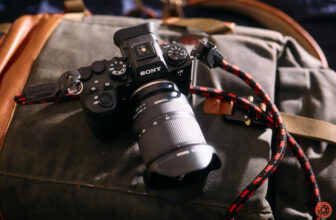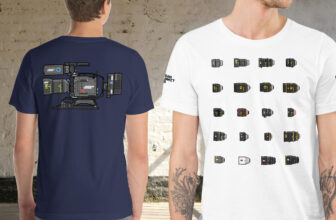
Check out our latest products
In this guide, we’ll cover the best digital camera lenses ideal for live streaming in a studio or at an event.
Selecting the best lenses for any genre demands research, understanding, word-of-mouth recommendations, and advice from other experienced photographers.
Having run a photography-related podcast for over a year, I’ve learned many truths about the best gear for live streaming.
The success and appeal of any live stream rely on two key elements: high-quality audio gear and a versatile set of sharp and fast lenses for superior video capture.
We’ll save the talk about audio gear for another day. Now, let’s dive in and discover the best lenses for live streaming in any environment.
My Favorite 8 Lenses for Live Streaming
Live streaming is a wonderfully creative genre of content creation that borrows heavily from tried-and-tested forms of journalism.
Like video-based journalism, live streaming can occur in a studio, a spare room, or in the field at an event or while travelling.
The beauty of live streams is the raw and often unscripted flow of information, perspectives, interactions, and experiences.
A live stream is an instant delivery of content without the benefit of post-production, editing, or the ability to have another go at it.
If it looks like garbage while live recording, there’s no saving it later in post-production.
As a result, you need the best lens for the job. Given the proximity of most cameras while live streaming, the best lens choices involve wide to standard primes and zooms.
Sigma 16mm f/1.4 (Best APS-C Lens for Studio Streaming)

Credit: Marc Bergreen
- Sharp image quality
- Close minimal focus distance
- Available for multiple mounts
- Highly affordable
- Lacks image stabilization
- Heavy on smaller MFT cameras
If you’re looking for the best APS-C lens for live studio work, the Sigma 16mm f/1.4 DC DN Contemporary is hard to ignore. Check out our full review here!
The weather-sealed Sigma wide prime lens boasts an impressive spec list and an even more impressive price tag. (P.S. – I know studio lenses don’t need to be weather sealed, but sometimes we take our lenses out for events and live vlogging.)
Designed to suit APS-C digital mirrorless cameras, the Sigma 16mm f/1.4 is a fast wide prime lens with a lens assembly consisting of 16 elements in 13 groups, including two aspherical, two SLD, and three FLD elements.
As a result, image quality is pristine even at the close working distance of 9.8″ (25 cm).
Despite its complex lens assembly, the Sigma is relatively compact and lightweight. It measures 2.8 x 3.6″ (72.2 x 92.6mm) and weighs 14.3oz (405g), making it ideal for handheld shooting too!


The fast and bright f/1.4 max aperture is perfect for studio work, thanks to its low-light performance, ability to deliver centre sharpness, and dreamy background blur.
The 16mm APS-C cropped lens offers a 24mm full-frame equivalent focal distance and a wide 83.2º field of view.
Sigma’s wide-angle 16mm f/1.4 DC DN Contemporary lens is available for Canon EF-M, Canon RF, Sony E, Nikon Z, Fujifilm X, Leica L, and MFT mounts.
At around US$500.00, it’s excellent value for money.
Canon RF [B&H] | Canon EF-M [Amazon | B&H] | Nikon Z [Amazon | B&H] | Sony E [Amazon | B&H] | Fujifilm [Amazon | B&H] | MFT [Amazon | B&H]
Sigma 18-35mm f/1.8 (Best DSLR APS-C Zoom Lens for Streaming)


- Constant f/1.8
- Old but awesome
- Excellent image sharpness
- Built like a tank
- Slow focus speed
- Heavy body
If you’re rocking an older APS-C format DSLR camera and want to get into live streaming, there’s a suite of high-quality first and third-party lenses regardless of the brand.
The Sigma 18-35mm f/1.8 DC HSM Art APS-C lens is an ideal live streaming option for Canon EF, Nikon F, and Sigma SA mount cameras.
Sigma’s 18-35mm wide zoom lens offers a 28.8-56mm full-frame equivalent focal range and a flexible 76.5° to 44.2° field of view.
The beauty of a wide zoom lens is its flexibility in shooting streams and video content with varying fields of view.
In a studio, that’s ideal, especially if your streams shift from single presenters to dual presenters or a group of guests. Zooming in and out to frame a perfect composition is hugely beneficial.


The Sigma 18-35mm f/1.8 features solid construction and a 17-element in 12-group internal lens assembly, including five SD and four aspherical elements.
Driven by Sigma’s Hyper Sonic Motor AF, focus speed and transitions in and out of focus are snappy and clean with minimal signs of focus breathing.
While the Sigma is an APS-C format lens measuring 3.07 x 4.76″ (78 x 121mm), it’s pretty heavy at 28.57oz (810g).
As a result, the lens is best suited to studio live streams over handheld vlogging. Over time, it will become quite heavy to hold comfortably for long periods.
If you’re looking for a fast and sharp DSLR APS-C wide-angle zoom for your next live stream, the Sigma 18-35mm f/1.8 DC HSM Art APS-C lens is your best bet.
It’s a flexible lens ideal for studio work or outdoor use with a tripod or gimbal. At around US$750.00, it’s also excellent value for money.
Canon EF-S [Amazon | B&H] | Nikon DX [Amazon | B&H]
Sigma 16-28mm f/2.8 (Best Sony FE Zoom Lens for Streaming)


- Lightweight and compact
- Flexible zoom range
- Perfect for vlogging
- Highly affordable
- 28mm too short for some
- Limited weather sealing
Sticking with the Sigma-love, our next lens is an impressive wide-angle zoom perfect for live streaming (indoors or out) with a Sony E full-frame digital mirrorless body.
The Sigma 16-28mm f/2.8 DG DN Contemporary lens for Sony E (also available for L-mount) is an impressive full-frame wide-angle zoom with excellent image quality and low-light performance.
Sigma’s 16-28mm f/2.8 is a compact and highly portable weather-sealed lens measuring 3 x 4″ (77.2 x 102.6mm) and weighing a comfortable 15.9oz (450g) – perfect for handheld vlogging or streaming on the go.
Internally, the Sigma boasts 16 elements in 11 groups and Sigma’s Super Multi-Layer and Nano Porous Coatings for optimal colour and detail in every frame.


It’s also worth pointing out that the Sigma 16-28mm features a relatively fast and constant f/2.8 maximum aperture, ideal for outdoor use or streaming from a well-lit studio.
At around US$900, it offers excellent performance at an affordable price.
Plus, the Sigma 16-28mm f/2.8 won the Best Wide-Angle Zoom Lens at the TIPA Awards and the Wide-Angle Zoom Lens of the Year award at the AP Awards in 2023
Alternatively, you could go for the Sony 16-35mm f/2.8 GM [Amazon | B&H] if you’re looking for top-notch image quality, build quality, and/or a bit more reach. It’s a GM lens, so you’ll get fantastic image quality, but you’ll be paying for it. Check out our full review here!
(There’s also a Sony 16-35mm f/2.8 GM II [Amazon | B&H], but that’s well over US$2,000 right now.)
Canon RF 15-35mm f/2.8 (Best Canon RF Zoom Lens for Streaming)


Credit: Marc Bergreen
- Excellent focus performance
- Brilliant image quality
- Pro-grade features
- Weather sealed
- Adaptive zoom range
- Expensive choice
- Robust yet heavy
While reputable third-party lens manufacturers like Sigma develop class-leading lenses for live streaming, sometimes pairing a camera with a native lens is the best option.
The Canon RF 15-35mm f/2.8 L IS USM is one of the best lenses in the Canon RF range. It’s also a highly versatile, pro-grade lens choice for content creators who produce live content at home, in a studio, or at an event.
Canon’s RF 15-35mm f/2.8 is a pro-grade L-series lens boasting image stabilization (IS) and the brand’s lightning-fast Nano USM AF system.
Focus performance is fast and sharp, and low-light outcomes are assured thanks to the ability to shoot handheld at slower speeds without degrading the live content.


Internally, the weather-sealed, full-frame wide zoom packs 16 elements in 12 groups, including two Ultra-Low Dispersion and three Aspherical elements to mitigate distortion and aberrations.
The Canon 15-35mm f/2.8 is a big, heavy L-series full-frame lens. It weighs 29.6oz (840g) and measures 3.48 x 5″ (88.5 x 126.8mm). The combined weight will impact handheld comfort when paired with a Canon full-frame R5 Mark II.
If you want pro-grade stream quality while working with a Canon R6 Mark II or R8, the Canon 15-35mm f/2.8 will cost around US$2,300.00.
It’s a significant step-up in price, but the image quality, snappy autofocus, smooth manual focus, image stabilization, and flexible 15-35mm full-frame focal range are worth it! Be sure to read our full review here.
Nikon Z 14-24mm f/2.8 S (Best Nikon Z Lens for Streaming)


- Exceptional image quality
- Lightweight design
- Dual control rings
- Customizable function button
- Pro-grade performance
- Expensive lens
- Unappealing background blur
It’s Nikon’s turn for a bit of love! For anyone shooting with a Nikon Z full-frame mirrorless camera, the best lens for live streaming is the Nikon Z 14-24mm f/2.8 S.
Muck like the Canon RF 15-35mm f/2.8 L above, the Nikon Z 14-28mm f/2.8 is an S-line lens, meaning it’s the pro-grade option for live streams with a Nikon Z camera.
While the lens is best paired with a full-frame Nikon Z8 or flagship Z9, it will also pair with Nikon DX (APS-C) format camera bodies such as the Z 50 Mark II, which produces a 21-36mm full-frame equivalent focal range.


In terms of image quality, the Z 14-28mm offers a consistent f/2.8 maximum aperture, and a 16-element in 11-group lens assembly boasting four ED and three aspherical elements, complemented by Nikon’s ARNEO and Nano Crystal coatings.
Nikon’s wide and flexible zoom also features a fast, quiet Stepping Motor AF system and a handy OLED panel to display core lens settings.
While the Nikon Z 14-28mm f/2.8 is a pro-grade lens, it’s relatively light at 22.9oz (650g) and measures 3.5 x 4.9″ (88.5 x 124.5mm).
As a result, it’s a great lens to pair with a full-frame or APS-C Nikon Z camera and is suited to studio, event, and handheld vlogging opportunities.
The Nikon Z 14-28mm f/2.8 S wide zoom lens retails for around US$2,000.
Sigma 24-70mm f/2.8 Mark II (Best Lens for Event Streaming)


- Flexible longer zoom range
- Constant f/2.8 max aperture
- Great image quality
- Affordable full-frame option
- Pro-grade features
- Minimal weather-sealing
- Corner softness wide open
Live streaming from an event creates unique challenges compared to preparing and recording content in a studio or home office.
Live-streamed events are often dynamic, and you don’t always know the setup or where you’ll be positioned to capture the action as it unfolds.
As a result, having a zoom lens with a longer focal range is ideal when you need more reach and/or want to do non-distorted close-ups or interviews.
The Sigma 24-70mm f/2.8 DG DN II Art lens is an incredibly versatile zoom with a versatile reach from wide to zoom.
Almost all brands offer this lens, and many event photographers use it as their primary lens. However, the Sigma version is the best value and most affordable.


Sigma’s full-frame 24-70mm f/2.8 II updates the hugely popular Mark I version of the same lens (reviewed here). The dust and splash-proof zoom packs some impressive specs!
The compact zoom measures just 3.5 x 4.8″ (87.8 x 122.2mm) and weighs 25.9oz (735g), which is incredible given its zoom range.
There’s no compromise to the lens performance thanks to a 19-element in 15-group lens assembly boasting six Low Dispersion (FLD), two Special Low Dispersion (SLD), and five aspherical lens elements.
For close-up work or compelling full-frame vlogging, the Sigma offers a 6.7″ (17cm) minimal focus distance and a flexible 84.1° to 34.3° field of view.
Sigma’s full-frame 24-70mm f/2.8 II is an ideal live streaming lens thanks to the High Response Linear Actuator (HLA) focusing system and suppressed focus breathing for natural focus pulls and maneuvers.
The Sigma 24-70mm f/2.8 DG DN II Art is one of the best live streaming lenses for Sony E and L-mount systems. It retails for around US$1,200, making it exceptional value for money.
If you’re okay with a little less on the wide end, the Tamron 28-75mm f/2.8 G2 [Amazon | B&H] and the Sigma 28-70mm f/2.8 [Amazon | B&H] are both excellent lenses at great prices. (The price of the Tamron for Sony right now is fantastic, although I prefer the Sigma – the shots come out less clinical.)
If you prefer a native lens, you can choose from the links below. (APS-C equivalents provided.)
Nikon FX [Amazon | B&H] | Nikon DX [Amazon | B&H] | Canon EF [Amazon | B&H] | Canon APS-C [Amazon | B&H] | Canon RF [Amazon | B&H] | Sony FE [Amazon | B&H] | Sony E [Amazon | B&H] | Fujifilm [Amazon | B&H] | Micro Four-Thirds [Amazon | B&H]
Fujifilm XF 16-55mm f/2.8 II (Best Fujifilm Lens for Streaming)


- Excellent image quality
- Pro-grade features and performance
- Optimised for video
- Mark II is lightweight!
- Constant f/2.8 apeture
- Expensive zoom lens
- Prefer internal zoom function
*** NOTE – THE ORIGINAL LENS IS NO LONGER AVAILABLE AND HAS BEEN UPDATED WITH A MARK II VERSION. LINK HERE FOR THE UPDATED PRODUCT***
Fujifilm X Series streamers capturing content on an X-T5 or the video-centric X-H2S have plenty of lens options available too!
The award-winning Fujifilm XF 16-55mm f/2.8 R LM WR II is yet another updated version of a superior Red Badge Fujifilm lens.
Fujifilm’s XF 16-55mm f/2.8 II offers superior image outcomes, responsive focusing, and premium build quality.
The 16-55mm APS-C format lens delivers a versatile 24-84mm full-frame equivalent focal range perfect for wider desk-based studio work and longer zoom work at live events.
Internally, the weather-sealed Fujifilm zoom features 16 elements in 11 groups, including super ED and aspherical elements. It also boasts an 11-bladed round aperture for outstanding background blur and bokeh.


While the Fujifilm XF 16-55mm f/2.8 R LM WR II is a workhorse photography lens, it also offers video-centric features and performance such as the declickable aperture ring and silent linear motor focusing system.
Given the XF 16-55mm pairs with Fujifilm’s compact digital mirrorless systems, it’s no surprise that the Mark II is significantly lighter than the original Mark I version.
Where the Mark I weighed 23oz (655g), the improved Mark II version has dropped to 14.5oz (410g). The XF 16-55mm f/2.8 measures 3.1 x 3.7″ (78.3 x 95mm) and extends to 4.8″ (122mm) when zoomed out.
Fujifilm’s premium XF 16-55mm f/2.8 R LM WR II retails for around US$1,200. If that’s too much for your budget, consider the Fujifilm XF 16-80mm f/4 [Amazon | B&H].
Panasonic Lumix 12-35mm f/2.8 II (Best MFT Lens for Streaming)


- Premium build quality
- Constant f/2.8
- Optically brilliant
- Dual I.S. compatibility
Panasonic Lumix has proven more than capable of developing class-leading videography cameras such as the Micro Four Thirds (MFT) GH5S. They also make exceptional lenses ideal for live streaming and video genres.
If you’re shooting with an MFT mount mirrorless camera, one of the best live streaming lenses is the Panasonic 12-35mm f/2.8. Its full name is Panasonic Leica DG Vario-Elmarit 12-35mm f/2.8 ASPH POWER O.I.S. – quite the mouthful!
The Panasonic 12-35mm f/2.8 MFT lens produces a versatile 24-70mm full-frame equivalent focal range perfect for a wide range of streaming settings.


The splash, dust, and freeze-proof lens boasts Panasonic’s POWER image stabilization and compatibility with MFT camera systems sporting 5 AXIS Dual IS 2.
Internally, the lightweight (10.8 oz (306g)) and compact (2.7 x 2.9″ (67.6 x 73.8mm)) zoom packs 14 elements in 9 groups, including aspherical UED and UHR elements.
The Panasonic/Leica co-engineered lens retails for around US$800, making it an exceptional value.
If you have a more controlled setup and don’t need the OIS, the Olympus 12-40mm f/2.8 [Amazon | B&H] is also a great choice. It has superior manual focus control and slightly better image quality, but is more expensive.
What To Look For When Buying a Streaming Lens
When buying a lens for live streaming, it’s essential to consider a few aspects of the genre and how a lens can meet your needs.
Focus Range
As we’ve discovered in the lens selection above, live streaming typically requires wider lenses over telephoto options.
A wider lens allows you to work handheld while vlogging with the camera at arm’s length away from your face. Wider lenses are also suitable for studio broadcasts where more than one presenter is on stream.
A prime wide lens with a 16mm full-frame equivalent is an excellent starting point. Alternatively, a wide zoom with a 15-35mm full-frame equivalent offers greater versatility for wide and tight shots.
Another hot tip is to use a wide lens as you’ll mount it close, allowing you to change the focal range or adjust a camera setting quickly.
Keep It Quiet
As with any video application, picking a quiet lens is essential. Older and cheaper lenses are less suited to live streaming as their focus motors and aperture rings are incredibly noisy – noise that a mic can easily pick up.
Fortunately, the current generation of lenses is developed with hybrid photography and videography in mind. As a result, they now include silent manual focus control, smooth yet quiet autofocus, and a declickable aperture ring.
Make It Manageable
One of the most important considerations when selecting a live stream lens is the size and weight, especially if you intend to stream many live vlogs!
A lens’s weight is manageable on its own. But when you pair it with a mid- to full-size digital mirrorless camera, the combined weight will quickly cause arm and hand fatigue—the dreaded Vlogger’s Arm.
Size and weight are far less critical if you work exclusively in a studio and intend to mount the camera on a tripod or desk.
Breath With Me
Another vital aspect to consider with a streaming lens is focus breathing.
Focus breathing occurs when the internal focusing elements shift to ensure focus remains on a subject. However, such a shift can momentarily cause the angle of view to breathe in and out.
It’s an unappealing artefact that less-complex and cheaper lenses often experience, especially if they’ve not been made for hybrid video/photography applications.
What Type of Camera is the Best For Streaming?
When it comes to selecting the best camera for live streaming, it’s timely to remember my advice at the top of this article.
The success and appeal of any live stream rely on two key elements: high-quality audio gear and a versatile set of sharp and fast lenses for superior video capture.
While you’re well and truly on your way to understanding the bit about the lenses, let’s talk about video and audio.
Video
While it’s possible to live stream in lower resolution formats such as 720p or even 1080p, the new industry standard is to record with a minimum 4K video resolution.
Fortunately, most current-gen hybrid mirrorless cameras offer at least a 4K recording option, allowing for full-sensor video capture at 24p or 30p.
Of course, the higher the resolution and the higher the frame rate, the more data the camera sensor captures and the better the outcomes.
But, and this is crucial, keep in mind that the more data you capture in-camera, the more data you have to transfer over Bluetooth or Wifi to stream your content live.
Audio
Built-in stereo microphones are good, but you’ll need a shoe-mounted shotgun microphone to get the best results, especially when shooting outdoors.
A shotgun microphone mounts to the top of the camera’s hot shoe and connects to the camera via a 3.5mm microphone jack. The included windshield captures clear, directional audio even from a distance.
Image Sensor
These days, full-frame digital mirrorless cameras offer a resolution of 50MP, APS-C cameras offer 40MP, and medium-format sensors can store up to 102MP of image data.
How much is too much for live streaming? Again, remember that you must transfer anything you record wirelessly or via tether. So size does matter!
Fortunately, most mirrorless cameras can shoot with the full-frame, or a crop of the sensor, allowing you to select how much video data is captured as you stream live.


Compatibility
Another key aspect of selecting the best camera for live streaming is its compatibility with desktop and app-based software. Hybrid still and video cameras often support direct-to-desktop tethering via a suitable cable.
In other cases, the camera features supportive tech to wirelessly stream content from the camera, directly to a dedicated app, before the app streams to your platforms and social media accounts.
Checking out the live streaming and content sharing options is a quick way to pick the best.
Focus Performance
While we rely heavily on a lens’s focus performance, it’s also necessary to know your streaming camera’s full capabilities.
Autofocus relates to the combined outcome of the paired camera and lens. A camera can have the fastest and most reliable focusing motors and performance worldwide. But if the lens is garbage, that fancy camera won’t achieve much (and vice versa).
Another key element to consider is the processor-based autofocus options. You want your camera to include face and eye subject detection and tracking.
That way, whether shooting a vlog or pointing the camera at a subject, the focus will stick to the human eye and retain sharp outcomes.
FAQs About the Best Lenses for Streaming
Is there a best lens for streaming?
The best live-stream lens is a full-frame 15-35mm (approximately) wide zoom with a relatively fast f/2.8 maximum aperture. The flexible field of view supports dynamic and adaptive videography. Excellent examples include the Canon RF 15-35mm f/2.8 L IS USM or the Sigma 16-28mm f/2.8.
What lens do most vloggers use?
Most vloggers use a 14mm or 16mm full-frame wide-angle prime and a fast maximum aperture lens for live vlog streams. With the camera held at arm’s length, a wide prime delivers a composition with the presenter’s face taking up the middle third of the view.
What’s the best focal length for live streaming?
The 24-70mm full-frame (or APS-C/MFT equivalent) zoom is the best focal length for live streaming. It’s a versatile focal range that covers expansive views for vlogs or group interviews, and the ability to zoom in for details or to gain reach at an event.
What is the best lens for streaming church services?
The best lens for a church service depends on the working space, how close you can get to the action, and the lighting. If you can set up a remote streaming camera close to the event, opt for a wide-angle prime with a bright f/1.4 max aperture. If you’re working from a distance, a 24-70mm or a 70-200mm with a constant f/2.8 aperture is ideal.
Is it better to use a webcam or a camera for streaming?
A digital mirrorless camera is a better option as it provides great freedom and flexibility, should you wish to stream from anywhere other than your desk. While webcams offer an all-in-one solution, a camera allows you to expand your lens kit and possibly genres beyond streaming.
What is the best lens for a webcam?
The best lens for a webcam should offer excellent image quality, a fast and bright maximum aperture, and a wide angle to support various stream outcomes.

![[2025 Upgraded] Retractable Car Charger, SUPERONE 69W Car Phone Charger with Cables Fast Charging, Gifts for Men Women Car Accessories for iPhone 16 15 14 13 12, Samsung, Black](https://i1.wp.com/m.media-amazon.com/images/I/61SaegZpsSL._AC_SL1500_.jpg?w=300&resize=300,300&ssl=1)



![[True Military-Grade] Car Phone Holder【2024 Stronger Suction & Clip】 Universal Cell Phone Holder for Car Mount for Dashboard Windshield Air Vent Long Arm Cell Phone Car Mount Thick Case,Black](https://i2.wp.com/m.media-amazon.com/images/I/715PBCuJezL._AC_SL1500_.jpg?w=300&resize=300,300&ssl=1)
![[エレコム] スマホショルダー ショルダーストラップ 肩掛け ストラップホールシート付属 丸紐 8mm P-STSDH2R08](https://i3.wp.com/m.media-amazon.com/images/I/51BMFf06pxL._AC_SL1500_.jpg?w=300&resize=300,300&ssl=1)







